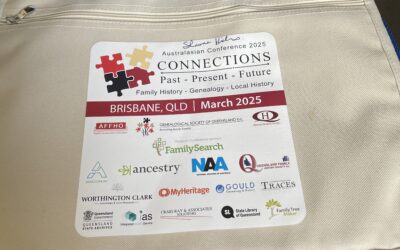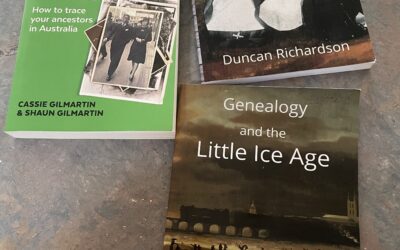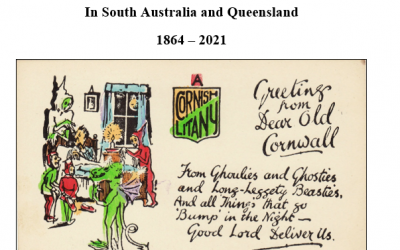This blog challenge is to stimulate my own genealogy blogging efforts in 2014 by focusing on a different kind of genealogical record each week. I wanted a challenge that reflected my own archival background as well as my own genealogy interests and there are probably lots of other records that I could have included. The challenge has an Australian focus but most of these records will be found just about anywhere in the genealogy world.
The 52 different types of genealogical records I finally decided on are listed in no particular order (each week will be a random surprise). Originally I planned to do this over 52 weeks but I now realise that I have to factor in travel and illness so it will continue a little bit over a year. Anyone is welcome to do all or part of this blogging challenge. Let me know if you are participating and I will put a link to your post under each week’s challenge.
So far I know of six bloggers who are taking up the challenge from time to time and I have put links to their individual entries at the end of each week’s blog if they have submitted something for that week. Thanks Judy Webster, Sharn White, Cassmob, Anne, Campaspe Library and Sharon for participating and encouraging me to keep up the blog challenge myself!
Also participating in this blog challenge: Sharon Week 12
Links to Week 1 Military Medals Week 2 Internal Migration Week 3 Probates (wills and administrations) Week 4 Memorial Cards Week 5 Family Stories Week 6 Land Records Week 7 Local Histories Week 8 Diaries Week 9 Inquest Records Week 10 Occupation Records Week 11 Newspapers
Week 12 Gazetteers
What is a gazetteer? A simple definition is that it is a publication which lists geographical places in alphabetical order plus giving some descriptive background information on the place. Not all that exciting as usually there is no detailed information on our ancestors but gazetteers can provide good background on where and how our ancestors lived and why they may have decided to move or emigrate to Australia.
Gazetteers can also be called by other names and perhaps Samuel Lewis’s topographical dictionaries are a perfect example. Back in the late 1970s I used his publications at the State Library of Queensland but today we can easily find them online for free. Researching does not get any easier than this! No excuse not to follow up this tip.
Lewis published topographical dictionaries for Ireland in 1837, Scotland in 1846, England in 1848 and Wales in 1849. These years are particularly apt for Australians researching their UK ancestors as most of our ancestors came out either before or after those descriptions of our ancestral places were published.
My Irish ancestor Adam Johnston arrived in Brisbane in 1861 and after a lot of research I finally discovered he was born in Bailieborough in County Cavan, Ireland. Lewis’s Topographical Dictionary of Ireland is in three volumes on the Ask About Ireland website. The entry for Bailieborough describes it as a market town and parish partly in County Meath but mostly in County Cavan, just over 42 miles north west of Dublin.
It had a population of 10,480 with 1085 in the town which consisted on one street with 165 houses. The land is described as generally of good quality with various grains growing and there are several bogs in the area. My Johnston family were Methodists here in Queensland and it is interesting to read that the Wesleyan Methodists had a place of worship in Bailieborough and divine service was performed every alternate Sunday. There was a parochial school, three public schools and 13 private schools. Adam was illiterate so obviously he did not get the opportunity for schooling despite the number of schools in the parish.
My Price family came from West Bromwich in Staffordshire and Lewis’s Topographical Dictionary of England in 1848 is available on the British History Online website. West Bromwich is a town and parish about six miles from Birmingham and in 1841 there were 26,121 inhabitants. The parish comprises nearly 6000 acres with about two thirds of the cultivated land arable and the remainder pasture. A considerable portion of land is occupied with buildings, collieries and brick-yards. It is a very old town and its history is given along with its rapid development as a manufacturing centre from the early 19th century. One of the reasons given for its rise was its coal and ironstone mines and this fits with my ancestors working as miners.
Lewis’s Topographical Dictionary of Scotland is also on the British History Online website and my Carnegie ancestors were from the town of Montrose in Scotland. It was a Royal Burgh, a seaport and a parish with 15,096 inhabitants, 72 miles north of Edinburgh. The principal manufactures carried on were the spinning of flax and weaving and again this is consistent with occupations given in the census. There were five mills for spinning linen yarn, four driven by steam-engines of 120-horse power and one driven by water. Schools, churches, the dispensary and lunatic asylum are all described and it gives a good description of the town my great great great grandparents left in 1865, not quite 20 years after Lewis’s publication. No doubt during that time the town increased its population and manufacturing greatly.
There is also a Lewis’s Topographical Dictionary of Wales on the British History Online website but I do not have any Welsh ancestors to provide a personal example.
Online gazetteers can be found by using a portal site such as Cyndi’s List of Genealogy Sites on the Internet. This site has dozens of categories but you can find gazetteers in the Maps and Geography section and then select the Locality Specific option to find resources quickly for your research areas. Genuki is a similar portal site for the UK and there is a category for Gazetteers.
By researching the places our ancestors left we may gain an insight into why they left . It can also help us to imagine what life was like for them living in those places at that time. Maps are useful to show where a place is but gazetteers give a much more descriptive look at places and can explain why our ancestors had certain occupations. Context is important in family history research and with so many gazetteers online there is no excuse for not checking them out and seeing what they can add to your research. Happy gazetteering!





0 Comments